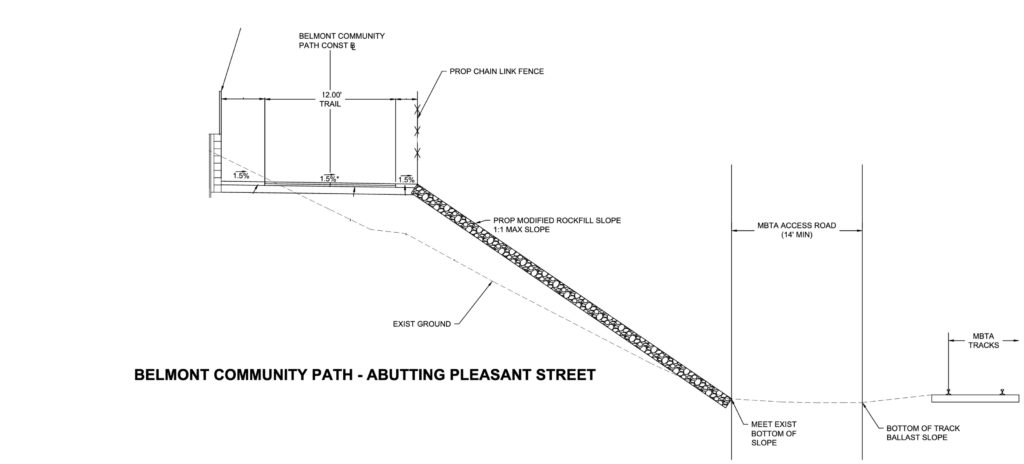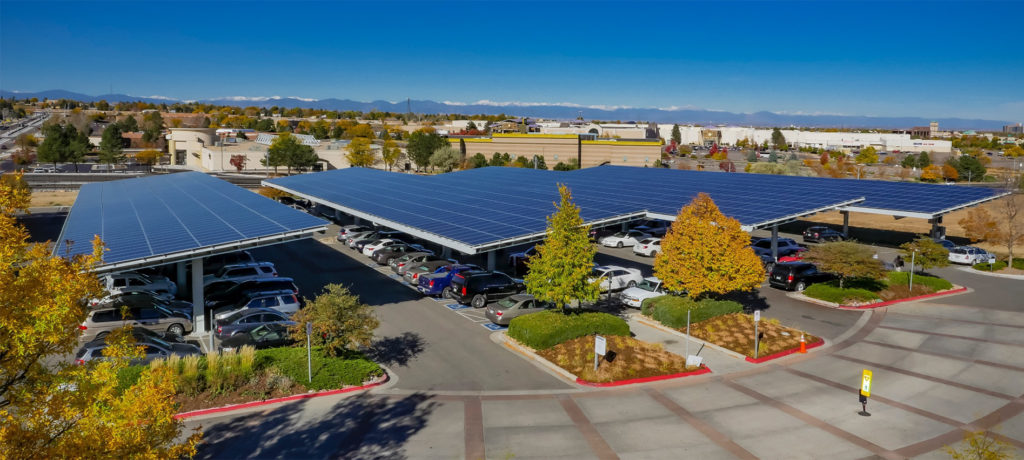
By Vincent Stanton, Jr.
Additional material—including calculations of how much energy could be generated—is available in the full version . Below is the version which appeared in the print newsletter. – Ed.
The imminent arrival of the Belmont Community Path prompts the question: what other productive uses might be devised for the Fitchburg Line corridor? One possibility is siting a south-facing solar photovoltaic (PV) array along the tracks.
Conditions for a PV array
Aspects of path layout relevant to design of a PV array include length, orientation to the sun, and the presence of a substrate to which PV panels can be attached. Moreover, the entire project would occupy an industrial brownfield site with no green potential, in contrast to the the potential for a proposed array at the former Belmont incinerator site. The proposed PV array would be close to important Belmont Light Department infrastructure: within 100 feet of the substation on Flanders Road, and within a few feet of the substation behind the old Belmont Municipal Light Department building on Concord Avenue.
The path will extend 6,090 feet from the west side of Brighton Street to the Clark Street Bridge and will be bordered on the railroad side by an eight-foot-tall chain link fence. All path measurements are from the 25% design drawings for the Belmont Community Path submitted to the Mass Department of Transportation in November 2021 and downloadable from the project website, belmontcommunitypath.com.
The fence is tall enough to accommodate two rows of PV panels attached at angles to optimize capture of solar radiation while avoiding shadows. Mounting panels on the fence between the path and the tracks would provide an additional layer of separation from train noise and possible debris. An MBTA service road will run between the tracks and fence, facilitating cleaning and maintenance of the panels or even seasonal repositioning for optimized solar ray collection.
Belmont Center to Brighton Street
The 5,000-foot path segment between Belmont Center and Brighton Street is oriented almost due east-west (parallel to the equator), allowing a due south-facing PV array facing the tracks, perfectly positioned for optimal sun collection and not shaded at any time of day. East of Brighton Street, the first 689 feet of the existing Fitchburg Cutoff Path are also located in Belmont and share the same properties (south facing, no shadows).
West of Belmont Center
West of Belmont Center the path bends southwest, and during some parts of the year, sections will be shaded in early morning and late afternoon by tall trees on the south side of the tracks, mostly during the winter months. However that afternoon shade should not meaningfully affect overall performance of the array, which is mostly driven by mid-day electricity generation.
Close to the Clark Street Bridge, the path gradually rises 20 feet from track level to the bridge, with a 387-foot-long riprap (loose stone) wall covering the steeply angled slope from the path down to track level. The surface area of the riprap wall is not provided in the drawings, but I estimate it is about 7,700 square feet. That wall could be covered with PV panels angled to face south at a 45 degree angle.
The MBTA and Belmont Light?
The entire PV array would be on MBTA property, as is most of the path. The MBTA owns approximately 40 feet north of the Fitchburg Line tracks. Why should the MBTA be interested in collaborating on a solar energy project?
First, the electrification of the commuter rail system is coming, though details and funding have not been worked out. From the MBTA’s website, under the heading Greening the Fleet: Decarbonizing the MBTA:
“As the MBTA plans for the future of the commuter rail system, we are considering the transition from diesel locomotives to an electrified system . . . The MBTA has launched the Rail Vision program that will identify cost-effective strategies to transform the existing commuter rail system. The modernized system will offer improved mobility and support our efforts to reduce greenhouse gas emissions.”
The advocacy group TransitMatters issued a detailed report last fall showing how the MBTA could electrify the entire commuter rail network for between $800 million and $1.5 billion.
Second, the MBTA is already generating large amounts of electricity from solar. In 2019, it finished installing solar canopies at 37 MBTA parking lots and garages.
These projects have been financed with a variety of partners. For example, all power generated by a 684 KW array installed over the parking lot at Nantasket Junction Station, and a 360 KW array covering the parking lot at West Hingham Station, is being purchased by Hingham Light, a municipally owned utility, via a power purchase agreement.
This innovative partnership could be a template for a relationship between the MBTA and Belmont Light. Though the MBTA is currently selling solar power to Hingham, the electrification of the commuter rail system, when it happens, will create increased demand for power, likely making the MBTA a buyer. Countries including India, England, and Germany are ahead of the United States in directly coupling rail-side solar PV installations to the electric traction systems that power the trains.
The electrification of the commuter rail system, when it happens, will create increased demand for power, likely making the MBTA a buyer.
The MBTA is not in the electric generation and distribution business. The 37 PV arrays on MBTA property were built and are maintained and owned by a developer who leases the space from the MBTA, which expects $55 million in rental income and savings on snow removal over the 20-year lease.
Similarly, Belmont Light could be the developer, operator, and owner of an array along the path, leasing the space from the MBTA. The contract might include a future electricity purchase option for the MBTA, anticipating electrification of the commuter rail, and also to charge electric buses that stop next to the path at the Belmont Center and Waverley Stations.
Project economics: battery backup
It will be years before the Fitchburg Line is electrified and the MBTA becomes a customer. To make a solar PV array economically attractive to Belmont Light today will likely require installing batteries which would allow supply and demand to be better matched.
To appreciate how addressing peak demand affects electricity prices, start by recognizing that the reliability of our electric system, at both the local and regional level, depends on having the capacity to deliver whatever amount of power is needed during the most energy-intensive hour of the year. In practice, that means maintaining a system that can deliver considerably more power than is needed on the average day.
For example, one important rationale for Belmont Light’s construction of a new 115 kV substation on Flanders Road (completed in 2016 at a net cost of $26.1 million) was that the old infrastructure would not have been able to handle increasing peak demand. At a regional level, about 20% of the electric generating capacity deemed necessary by the New England power regulator (ISO-NE), is used only 2% of the time. It is expensive to maintain that extra capacity, and the cost is reflected in a forward capacity charge that is determined by power usage at peak hours in the previous year. Capacity charges are unpredictable (though the trend is up). If Belmont Light were able to consistently and predictably reduce its peak demand, it would lower its capacity charges and hence its rates for Belmont residents.
In addition to capacity charges, the marginal price of electricity at times of high demand is a cost driver. As covered in the August/September 2014 BCF Newsletter (“Solar Electricity Pricing Plans Debated”), on hot summer days when electric demand is at its peak, Belmont Light (like other utilities) has to buy electricity on the spot market to supplement electricity purchased via long-term contracts. Spot prices tend to be high at such times; 10- to 20-fold variation in price is not unusual. In short, being able to predictably reduce spot market purchases also reduces costs. Together with the forward capacity charge reductions, these spot price reductions are transformational for solar PV economics.
The best publicized example of the powerful economics of battery storage plus intermittent renewable power (solar or wind) is a 100 megawatt (MW) Tesla battery installation in South Australia, which reportedly saved about $35M in its first four months of service in late 2017, while reducing the cost of conventional power backup (mostly gas-fired turbines) by 90%. The $50M system paid for itself in six months.
Case study: Sterling’s battery system
The attractive economics of solar PV coupled with battery storage have also been demonstrated locally by Sterling Municipal Light (SMLD), a Massachusetts utility which offers some of the lowest electric rates in the state. SMLD operates over 4.5 MW of PV in Sterling, built and owned by independent developers who signed power purchase agreements with the utility.
In 2016, SMLD installed a 2 MW/3.9 MWH battery storage facility at a cost of $2.7 million, defrayed by $1.71M in state and federal grant support. Sterling lowers its demand for electricity from ISO-NE by discharging the battery system during peak demand hours. The system saves electric ratepayers about $400,000 per year by decreasing costs associated with capacity and transmission charges. With the grant support, the project had a payoff period of 2.5 years (vs. 7 years without grants). An additional benefit of the Sterling system is that it provides a dependable power source for first responders as part of an overall municipal vulnerability preparedness plan. Sterling has a population of 8,190 (one third of Belmont), so the scale of a battery system in Belmont would likely be larger.
Unlike Sterling and several other municipally owned Massachusetts utilities, Belmont Light does not own any electrical-generating capacity, so it must purchase all of its power. Participating in the design of an array would allow Belmont Light to optimize design features to the contours of Belmont demand (e.g., orienting panels to produce more electricity in the late afternoon closer to peak demand).
How to finance such a project is beyond the scope of this article, but it is worth noting that the level of participation of Belmont citizens in solar roof and electric car promotions sponsored by the Energy Committee in recent years have been among the highest in the state, yet many residents are not able to participate either because their roof is not suitable for solar, was just replaced, or they can’t afford the upfront costs of a roof array or an electric car. Instead, Belmont residents could purchase interest-bearing bonds to finance construction of a PV array from which they (via Belmont Light) would be purchasing power. Littleton Electric Light customers have piloted such a program.
Extension to property flanking the path
The array discussed here utilizes Phase 1 of the Belmont Community Path project. Phase 2 of the path, from the Clark Street Bridge to the Waltham line, would be expected to nearly double the size of a PV array. A much bigger opportunity, however, lies in all of the flat-topped industrial buildings and large parking lots that lie within 150 feet of the path. Construction of PV arrays on even half of the available surfaces could produce a network of arrays with no loss of green space.
For additional material including sample calculations of how much energy would be generated by these arrays, see bit.ly/BCF-Solar-Path-Extras
Vincent Stanton, Jr., is a director of the Belmont Citizens Forum and a member of the Belmont Community Path Project Committee. The ideas and opinions in this article are his alone.




Sorry, the comment form is closed at this time.